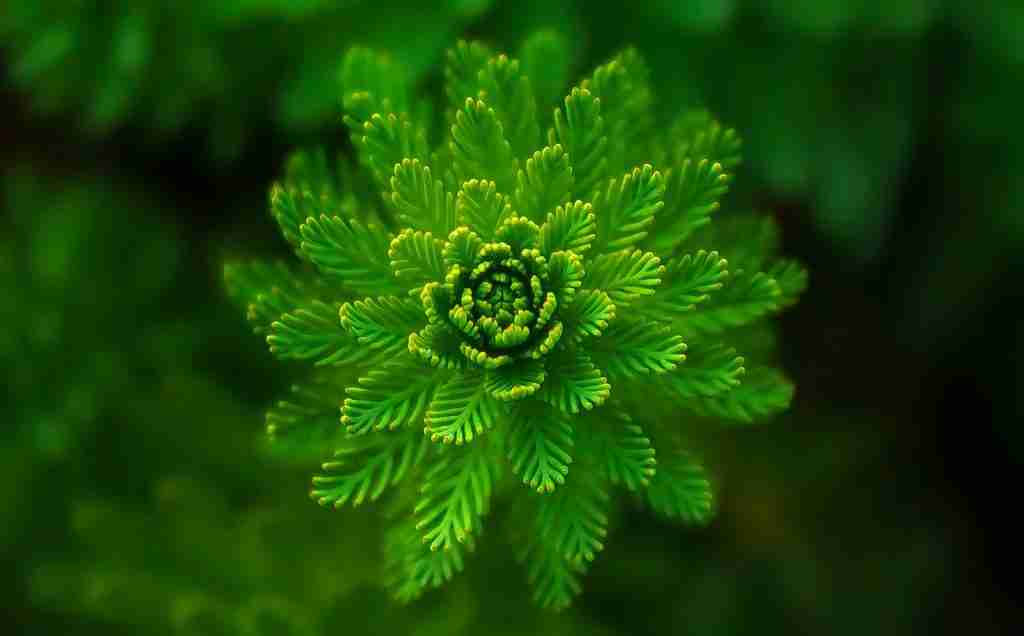24 Fun Facts About The Color Green That Will Make You Green
1. Green is the color of chlorophyll, which is responsible for the process of photosynthesis in plants.
This process is essential for plant survival and produces oxygen for the atmosphere.
Chlorophyll absorbs light most efficiently in the blue and red parts of the spectrum, reflecting green light, which gives plants their characteristic color.
2. The word green comes from the Middle English word grene, which means growing.
The word “green” boasts a history that stretches back centuries. Its roots lie in Middle English, where it appeared as “grene,” signifying something that’s growing or flourishing. This association with growth likely stems from the Proto-Germanic word “grōni-,” which carries the same meaning.
Ultimately, the word “green” can be traced back to a Proto-Indo-European root meaning “to grow” (gʰreh₁-). This connection makes perfect sense, as green is so often linked with the vibrant hues of nature and life itself.
3. Green is a secondary color that can be created by mixing yellow and blue.
The world of color bursts with possibilities, and green takes center stage as a secondary color. Unlike primary colors like red, blue, and yellow, green isn’t readily available on your paint palette.
Instead, it’s a product of artistic alchemy, born from the perfect blend of sunshine yellow and calming blue. This vibrant mix can take on countless variations, from the verdant greens of spring foliage to the deep, mysterious tones of the ocean floor.
4. A green room is the backstage area where performers wait in theaters and TV studios before going on stage.

The green room isn’t fancy. It’s a basic backstage waiting area but a lifeline for performers. Here, jitters simmer alongside hushed concentration. Actors tweak costumes and singers hum scales.
Laughter cuts through the nervous tension as veterans loosen up while newbies try to find their center. It’s a brief world between the ordinary and the extraordinary, where performers morph into the characters they’ll become, readying themselves to face the bright lights.
5. Green, known for its attention-grabbing qualities, is often preferred for signage and advertisements.
Green, renowned for its eye-catching appeal, is frequently chosen for signs and advertisements due to its vibrant and lively hue. This color draws attention and evokes feelings of freshness and vitality, making it an excellent choice for marketing materials. It stands out in urban and rural settings and is often used to convey safety and harmony.
Additionally, its psychological impact includes promoting a sense of calm and relaxation, further enhancing its effectiveness in public displays. This versatile color can significantly increase visibility and engagement as a strategic visual communication tool.
6. The green M&M was introduced in 1976 as a response to customer feedback that requested more colors.
It was part of a marketing campaign to revitalize the brand and boost sales.
The green M&M has since become a recognizable part of the M&M candy line.
7. Night vision goggles utilize the color green because it corresponds to the human eye’s heightened sensitivity and ability to discern a wide range of shades.
Night vision goggles utilize green due to their high visibility in low-light conditions, aligning with the peak sensitivity of the human eye’s vision in darkness. This choice enhances clarity and reduces eye strain, making it easier for users to see detailed images during extended periods.
Green light’s longer wavelength is better processed by night vision technology, improving the contrast and effectiveness of these devices in various environments. This spectral preference is also practical, ensuring compatibility with other optical technologies.
8. Green is the national color of Ireland.

Green, It’s everywhere in Ireland, like the shamrock on St. Patrick’s Day. The rolling hills and grass are green, almost like Ireland’s favorite color.
Even their flag has green on it, along with other colors. So next time you see something green, think of Ireland.
9. The Hulk, a popular comic book character, is known for his green skin.
The Hulk is a Marvel Comics character known for his incredible strength, massive size, and green skin.
He was originally depicted as gray, but a printing error resulted in him being portrayed with green skin.
This change proved popular with readers and became a defining characteristic of the character, who has since been featured in numerous comic book series, television shows, and movies.
10. The Green Lantern is a DC Comics superhero known for his green power ring.
The Green Lantern is a DC Comics superhero who uses a green power ring to create solid constructs out of green energy and grants him flight and other powers.
A ring is a tool of the Green Lantern Corps, an intergalactic police force responsible for maintaining peace and order in the universe.
The character has been popular in the DC Comics universe and has been featured in numerous comic book series, television shows, and movies.
11. In North American stock markets, green signifies a rise in stock prices, while in East Asian markets, it indicates a decline.
Stock market colors can be a real head-scratcher. In North America, seeing charts filled with green is a cause for celebration. It means stock prices are climbing, making investors happy campers.
But travel across the Pacific to East Asia, and that green takes on a whole new meaning. Here, green signifies a downturn in stock prices – not exactly the news you want to see.
12. The Green Party is a political party that focuses on environmental issues.
The Green Party is a political party that prioritizes environmentalism and sustainability.
Green Party was founded in Germany in the 1970s and has since spread to many other countries around the world. Its platforms typically advocate for policies prioritizing environmental protection, combatting climate change, and promoting social justice.
The party has gained significant support in many countries and has been successful in electing members to various levels of government.
13. During the 1960s, in US high schools, wearing green on Thursdays was believed to signify homosexuality.
Whispers swirled through some US high schools in the 1950s and 60s: wearing green on Thursdays signaled you were gay or lesbian. However, this rumor was more a reflection of the times than a reliable indicator.
Back then, LGBTQ+ identities weren’t openly acknowledged, and judging someone’s sexuality by clothes was a recipe for misunderstandings.
14. After blue, green ranks as the second most favored color among people.
Green takes the silver medal when it comes to color preference, following closely behind the ever-popular blue. That’s right, green seems to resonate with a whopping 16% of people across the globe, making it a strong contender in the color popularity contest.
Perhaps it’s the calming connection to nature or the refreshing vibes it evokes. Whatever the reason, green sits comfortably on the color podium, a clear favorite for many.
15. The color green stimulates creativity and promotes feelings of harmony and balance.
Its calming effect on the mind and body makes it popular for home decor, workplaces, and healthcare facilities.
Studies have shown that exposure to green can reduce stress and anxiety and improve overall mood.
16. In Japan, green tea is a popular beverage that is consumed for its health benefits.
It is made from Camellia sinensis leaves and is known for its high levels of antioxidants and polyphenols, which are believed to have numerous health benefits.
Green tea is also a key component of traditional Japanese tea ceremonies and is often used in cooking and baking.
17. The Green Revolution was a period of rapid agricultural development.
The Green Revolution, which occurred between the 1940s and the 1960s, was a period of significant agricultural advancements that helped to increase food production globally.
It was primarily focused on developing and adopting high-yielding crop varieties and improved irrigation and fertilizer use.
The Green Revolution is credited with helping to alleviate food shortages and improve food security in many parts of the world.
18. Green cards are issued to foreign nationals in the United States.

The United States issues green cards, also known as permanent resident cards, to foreign nationals who are authorized to live and work in the country permanently.
The cards serve as proof of legal permanent residency and are issued by the United States Citizenship and Immigration Services (USCIS).
Green cards provide various benefits, including the ability to apply for certain government benefits and travel outside of the United States without losing their status.
19. The Green Belt Movement is a grassroots organization in Kenya.
The Green Belt Movement is an environmental organization founded in 1977 by Kenyan activist Wangari Maathai.
It aims to promote sustainable development and conservation by planting trees, empowering women, and advocating for environmental policies.
The organization has planted millions of trees in Kenya and other countries and has won several awards for its work.
20. Green is the color of the iconic Statue of Liberty in New York City.
The Statue of Liberty, located in New York City, is a symbol of freedom and democracy in the United States. It is made of copper and was gifted to the US by France in 1886.
The statue’s original color was brown, but due to the natural process of oxidation, it turned green over time.
Today, the green color of the statue is an iconic symbol recognized worldwide.
21. Green is often associated with luck and good fortune in many cultures.
In Chinese culture, the color green represents growth, harmony, and wealth. In Ireland, the shamrock, which is green in color, is considered a symbol of good luck.
In Hinduism, green is associated with life and happiness and is often used during festivals and ceremonies.
Similarly, in Islamic culture, green is considered a holy color and is often used in religious and cultural events.
22. In ancient Egypt, green was considered to be the color of rebirth and regeneration.

Green was considered the color of rebirth and regeneration in ancient Egypt.
It was associated with Osiris, the god of the afterlife and regeneration, and was used in art, architecture, and decorative objects.
Green was also used in the decoration of tombs and mummies, emphasizing its connection with rebirth and regeneration in the afterlife.
23. Green is the color of the fourth chakra.
In Hinduism and some forms of alternative medicine, the fourth chakra is associated with the color green.
It is located in the center of the chest and is responsible for emotions such as love, compassion, and forgiveness.
The color green represents balance, harmony, and healing energy, and practices such as meditation and yoga are often used to activate and balance this chakra.
24. Venus is associated with green, often portraying it as the color of love.
Venus, the dazzling evening star, isn’t just about love. In some cultures, green peeks through as a surprising symbol. Green, linked to growth and new beginnings, reflects Venus’s role as the love goddess. It’s like spring – green shoots and blossoming love.
This green connection might be less common, but it adds another layer of intrigue to Venus, the celestial beauty.
FAQS
Green has many positive associations. It’s often linked to nature, making us think of lush landscapes and fresh growth. This connection to nature gives green a calming and peaceful feel. Green can also represent new beginnings, health, and wealth.
Green wears two hats. It often refers to the color we see in nature – like leaves and grass. Think of a lush forest or a freshly mowed lawn.
But green can also have a figurative meaning, referring to someone who’s new to something and still gaining experience. For example, you might hear someone say they’re green at a new job, meaning they’re still learning the ropes.
Sage green is a chameleon of color palettes. Paired with creams, whites, or taupes can create calming vibes for a nature-inspired look. Want a bolder statement? Try mustard yellow, black, or deep pink accents. Feeling zen? Blues and grays offer a cool and tranquil atmosphere.
Green is generally considered a happy color. It evokes feelings of peace and calmness because of its association with nature. Think of lush landscapes, fresh growth, and springtime. This connection to nature can give you a sense of renewal and optimism, making green a happy hue for many.
Green’s luck depends on culture. In many places, like China and Ireland, green is strongly associated with good fortune. It represents growth, wealth, and harmony. But, in some cultures, green might have negative connotations. For instance, in some gambling traditions, it might symbolize loss.







